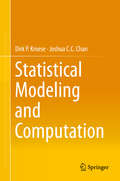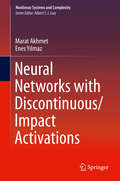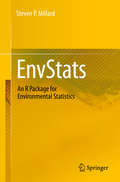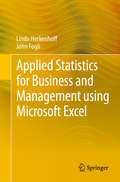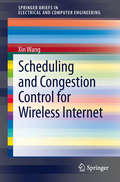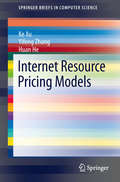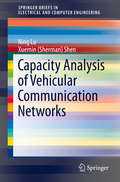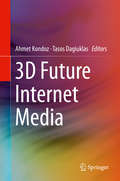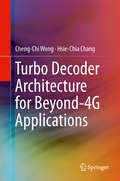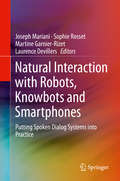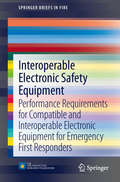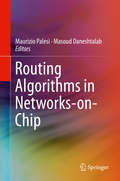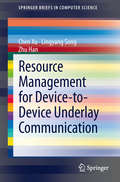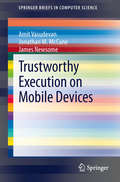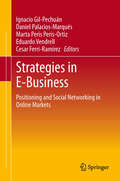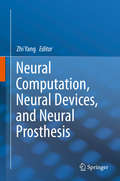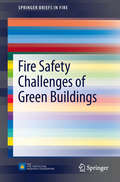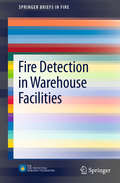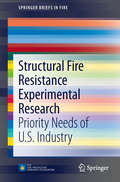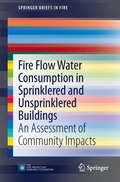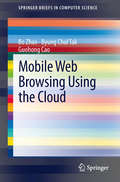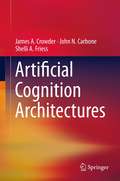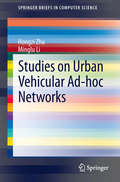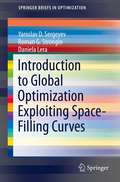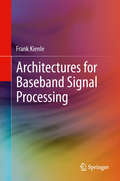- Table View
- List View
Statistical Modeling and Computation
by Dirk P. Kroese Joshua C.C. ChanThis textbook on statistical modeling and statistical inference will assist advanced undergraduate and graduate students. Statistical Modeling and Computation provides a unique introduction to modern Statistics from both classical and Bayesian perspectives. It also offers an integrated treatment of Mathematical Statistics and modern statistical computation, emphasizing statistical modeling, computational techniques, and applications. Each of the three parts will cover topics essential to university courses. Part I covers the fundamentals of probability theory. In Part II, the authors introduce a wide variety of classical models that include, among others, linear regression and ANOVA models. In Part III, the authors address the statistical analysis and computation of various advanced models, such as generalized linear, state-space and Gaussian models. Particular attention is paid to fast Monte Carlo techniques for Bayesian inference on these models. Throughout the book the authors include a large number of illustrative examples and solved problems. The book also features a section with solutions, an appendix that serves as a MATLAB primer, and a mathematical supplement.
Neural Networks with Discontinuous/Impact Activations
by Marat Akhmet Enes YılmazThis book presents as its main subject new models in mathematical neuroscience. A wide range of neural networks models with discontinuities are discussed, including impulsive differential equations, differential equations with piecewise constant arguments, and models of mixed type. These models involve discontinuities, which are natural because huge velocities and short distances are usually observed in devices modeling the networks. A discussion of the models, appropriate for the proposed applications, is also provided.
EnvStats
by Steven P. MillardThis book describes EnvStats, a new comprehensive R package for environmental statistics and the successor to the S-PLUS module EnvironmentalStats for S-PLUS (first released in 1997). EnvStats and R provide an open-source set of powerful functions for performing graphical and statistical analyses of environmental data, bringing major environmental statistical methods found in the literature and regulatory guidance documents into one statistical package, along with an extensive hypertext help system that explains what these methods do, how to use these methods, and where to find them in the environmental statistics literature. EnvStats also includes numerous built-in data sets from regulatory guidance documents and the environmental statistics literature. This book shows how to use EnvStats and R to easily: * graphically display environmental data * plot probability distributions * estimate distribution parameters and construct confidence intervals on the original scale for commonly used distributions such as the lognormal and gamma, as well as do this nonparametrically * estimate and construct confidence intervals for distribution percentiles or do this nonparametrically (e. g. , to compare to an environmental protection standard) * perform and plot the results of goodness-of-fit tests * compute optimal Box-Cox data transformations * compute prediction limits and simultaneous prediction limits (e. g. , to assess compliance at multiple sites for multiple constituents) * perform nonparametric estimation and test for seasonal trend (even in the presence of correlated observations) * perform power and sample size computations and create companion plots for sampling designs based on confidence intervals, hypothesis tests, prediction intervals, and tolerance intervals * deal with non-detect (censored) data * perform Monte Carlo simulation and probabilistic risk assessment * reproduce specific examples in EPA guidance documents EnvStats combined with other R packages (e. g. , for spatial analysis) provides the environmental scientist, statistician, researcher, and technician with tools to "get the job done!"
Applied Statistics for Business and Management using Microsoft Excel
by Linda Herkenhoff John FogliApplied Business Statistics for Business and Management using Microsoft Excel is the first book to illustrate the capabilities of Microsoft Excel to teach applied statistics effectively. It is a step-by-step exercise-driven guide for students and practitioners who need to master Excel to solve practical statistical problems in industry. If understanding statistics isn't your strongest suit, you are not especially mathematically-inclined, or if you are wary of computers, this is the right book for you. Excel, a widely available computer program for students and managers, is also an effective teaching and learning tool for quantitative analyses in statistics courses. Its powerful computational ability and graphical functions make learning statistics much easier than in years past. However, Applied Business Statistics for Business and Management capitalizes on these improvements by teaching students and practitioners how to apply Excel to statistical techniques necessary in their courses and workplace. Each chapter explains statistical formulas and directs the reader to use Excel commands to solve specific, easy-to-understand business problems. Practice problems are provided at the end of each chapter with their solutions.
Scheduling and Congestion Control for Wireless Internet
by Xin WangThis brief proposes that the keys to internet cross-layer optimization are the development of non-standard implicit primal-dual solvers for underlying optimization problems, and design of jointly optimal network protocols as decomposition of such solvers. Relying on this novel design-space oriented approach, the author develops joint TCP congestion control and wireless-link scheduling schemes for wireless applications over Internet with centralized and distributed (multi-hop) wireless links. Different from the existing solutions, the proposed schemes can be asynchronously implemented without message passing among network nodes; thus they are readily deployed with current infrastructure. Moreover, global convergence/stability of the proposed schemes to optimal equilibrium is established using the Lyapunov method in the network fluid model. Simulation results are provided to evaluate the proposed schemes in practical networks.
Internet Resource Pricing Models
by Huan He Yifeng Zhong Ke XuThis brief guides the reader through three basic Internet resource pricing models using an Internet cost analysis. Addressing the evolution of service types, it presents several corresponding mechanisms which can ensure pricing implementation and resource allocation. The authors discuss utility optimization of network pricing methods in economics and underline two classes of pricing methods including system optimization and entities' strategic optimization. The brief closes with two examples of the newly proposed pricing strategy helping to solve the profit distribution problem brought by P2P free-riding and improve the pricing efficiency with the introduction of the price discrimination. The Internet resource pricing strategy is not only the key factor of Internet resource allocation efficiency, but also the determinant of the profit. The methods and models discussed in Internet Resource Pricing Models increase the efficiency of existing pricing strategies to ensure a sound and sustainable development of the Internet. The brief will help researchers and professionals working with this key factor of Internet resource allocation.
Capacity Analysis of Vehicular Communication Networks (SpringerBriefs in Electrical and Computer Engineering)
by Ning Lu Xuemin Sherman ShenThis SpringerBrief focuses on the network capacity analysis of VANETs, a key topic as fundamental guidance on design and deployment of VANETs is very limited. Moreover, unique characteristics of VANETs impose distinguished challenges on such an investigation. This SpringerBrief first introduces capacity scaling laws for wireless networks and briefly reviews the prior arts in deriving the capacity of VANETs. It then studies the unicast capacity considering the socialized mobility model of VANETs. With vehicles communicating based on a two-hop relaying scheme, the unicast capacity bound is derived and can be applied to predict the throughput of real-world scenarios of VANETs. The downlink capacity of VANETs is also investigated in which access infrastructure is deployed to provide pervasive Internet access to vehicles. Different alternatives of wireless access infrastructure are considered. A lower bound of downlink capacity is derived for each type of access infrastructure. The last section of this book presents a case study based on a perfect city grid to examine the capacity-cost trade-offs of different deployments since the deployment costs of different access infrastructure are highly variable.
3D Future Internet Media
by Ahmet Kondoz Tasos DagiuklasThis book describes recent innovations in 3D media and technologies, with coverage of 3D media capturing, processing, encoding, and adaptation, networking aspects for 3D Media, and quality of user experience (QoE). The main contributions are based on the results of the FP7 European Projects ROMEO, which focus on new methods for the compression and delivery of 3D multi-view video and spatial audio, as well as the optimization of networking and compression jointly across the Future Internet (www. ict-romeo. eu). The delivery of 3D media to individual users remains a highly challenging problem due to the large amount of data involved, diverse network characteristics and user terminal requirements, as well as the user's context such as their preferences and location. As the number of visual views increases, current systems will struggle to meet the demanding requirements in terms of delivery of constant video quality to both fixed and mobile users. ROMEO will design and develop hybrid-networking solutions that combine the DVB-T2 and DVB-NGH broadcast access network technologies together with a QoE aware Peer-to-Peer (P2P) distribution system that operates over wired and wireless links. Live streaming 3D media needs to be received by collaborating users at the same time or with imperceptible delay to enable them to watch together while exchanging comments as if they were all in the same location. The volume provides state-of-the-art information on 3D multi-view video, spatial audio networking protocols for 3D media, P2P 3D media streaming, and 3D Media delivery across heterogeneous wireless networks among other topics. Graduate students and professionals in electrical engineering and computer science with an interest in 3D Future Internet Media will find this volume to be essential reading.
Turbo Decoder Architecture for Beyond-4G Applications
by Cheng-Chi Wong Hsie-Chia ChangThis book describes the most recent techniques for turbo decoder implementation, especially for 4G and beyond 4G applications The authors reveal techniques for the design of high-throughput decoders for future telecommunication systems, enabling designers to reduce hardware cost and shorten processing time Coverage includes an explanation of VLSI implementation of the turbo decoder, from basic functional units to advanced parallel architecture. The authors discuss both hardware architecture techniques and experimental results, showing the variations in area/throughput/performance with respect to several techniques. This book also illustrates turbo decoders for 3GPP-LTE/LTE-A and IEEE 802. 16e/m standards, which provide a low-complexity but high-flexibility circuit structure to support these standards in multiple parallel modes. Moreover, some solutions that can overcome the limitation upon the speedup of parallel architecture by modification to turbo codec are presented here. Compared to the traditional designs, these methods can lead to at most 33% gain in throughput with similar performance and similar cost.
Natural Interaction with Robots, Knowbots and Smartphones
by Joseph Mariani Sophie Rosset Martine Garnier-Rizet Laurence DevillersThese proceedings presents the state-of-the-art in spoken dialog systems with applications in robotics, knowledge access and communication. It addresses specifically: 1. Dialog for interacting with smartphones; 2. Dialog for Open Domain knowledge access; 3. Dialog for robot interaction; 4. Mediated dialog (including crosslingual dialog involving Speech Translation); and,5. Dialog quality evaluation. These articles were presented at the IWSDS 2012 workshop.
Interoperable Electronic Safety Equipment: Performance Requirements for Compatible and Interoperable Electronic Equipment for Emergency First Responders
by Casey C GrantFirefighters and other emergency first responders use a huge variety of highly specialized and critical technologies for personal protection. These technologies, ranging from GPS to environmental sensing to communication devices, often run on different systems with separate power supplies and operating platforms. How these technological components function in a single synergistic system is of critical interest to firefighter end-users seeking efficient tools. Interoperable ESE states that a standardized platform for electronic safety equipment (ESE) is both logical and essential. This book develops an inventory of existing and emerging electronic equipment categorized by key areas of interest to the fire service, documents equipment performance requirements relevant to interoperability, including communications and power requirements, and develops an action plan toward the development of requirements to meet the needs of emergency responders. This book is intended for practitioners as a tool for understanding interoperability concepts and the requirements of the fire service landscape. It offers clear recommendations for the future to help ensure efficiency and safety with fire protection equipment. Researchers working in a related field will also find the book valuable.
Routing Algorithms in Networks-on-Chip
by Maurizio Palesi Masoud DaneshtalabThis book provides a single-source reference to routing algorithms for Networks-on-Chip (NoCs), as well as in-depth discussions of advanced solutions applied to current and next generation, many core NoC-based Systems-on-Chip (SoCs). After a basic introduction to the NoC design paradigm and architectures, routing algorithms for NoC architectures are presented and discussed at all abstraction levels, from the algorithmic level to actual implementation Coverage emphasizes the role played by the routing algorithm and is organized around key problems affecting current and next generation, many-core SoCs. A selection of routing algorithms is included, specifically designed to address key issues faced by designers in the ultra-deep sub-micron (UDSM) era, including performance improvement, power, energy, and thermal issues, fault tolerance and reliability.
Resource Management for Device-to-Device Underlay Communication
by Chen Xu Zhu Han Lingyang SongDevice-to-Device (D2D) communication will become a key feature supported by next generation cellular networks, a topic of enormous importance to modern communication. Currently, D2D serves as an underlay to the cellular network as a means to increase spectral efficiency. Although D2D communication brings large benefits in terms of system capacity, it also causes interference as well as increased computation complexity to cellular networks as a result of spectrum sharing. Thus, efficient resource management must be performed to guarantee a target performance level of cellular communication. This brief presents the state-of-the-art research on resource management for D2D communication underlaying cellular networks. Those who work with D2D communication will use this book's information to help ensure their work is as efficient as possible. Along with the survey of existing work, this book also includes the fundamental theories, key techniques, and applications.
Trustworthy Execution on Mobile Devices
by Amit Vasudevan James Newsome Jonathan M. MccuneThis brief considers the various stakeholders in today's mobile device ecosystem, and analyzes why widely-deployed hardware security primitives on mobile device platforms are inaccessible to application developers and end-users. Existing proposals are also evaluated for leveraging such primitives, and proves that they can indeed strengthen the security properties available to applications and users, without reducing the properties currently enjoyed by OEMs and network carriers. Finally, this brief makes recommendations for future research that may yield practical and deployable results.
Strategies in E-Business
by Ignacio Gil-Pechuán Daniel Palacios-Marqués Marta Peris Peris-Ortiz Eduardo Vendrell Cesar Ferri-RamirezIn this volume, the authors apply insights from a variety of perspectives to explore the alignment among strategy, organization design, process and human resource management, and e-business practices on developing successful social networking programs--with particular regard to applying such initiatives against the backdrop of the global financial crisis and challenges to traditional business models. Showcasing in-depth case studies, the authors present emerging approaches to analyze the impact of investment in social networking sites, aligning internal resources, and measuring effects on positioning, branding, and new business creation. The fact that a growing proportion of the world population has a relationship with social networking sites could prove very valuable for companies. The question is whether this represents a business opportunity, whether companies know how to make the most of it and if they will make the necessary efforts to adapt to these new platforms. In the modern world, social networking sites have enormous potential for large as well as small and medium-sized enterprises (SMEs); most companies are aware of the need for a presence on social networking sites, but at present their e-business strategies are part of their medium and long-term strategic planning and only a small percentage have been put into practice. In short, this book attempts to answer the following questions: Is there a business opportunity for companies on social networking sites? Do they know how to make the most of it? Are they willing to make the necessary effort to adapt? Can e-business strategies contribute to company creation and the success of already existing businesses? And if so, how?
Neural Computation, Neural Devices, and Neural Prosthesis
by Zhi YangIn the past decades, interdisciplinary investigations overlapping biology, medicine, information science, and engineering have formed a very exciting and active field that attracts scientists, medical doctors, and engineers with knowledge in different domains. A few examples of such investigations include neural prosthetic implants that aim to improve the quality of life for patients suffering from neurologic disease and injury; brain machine interfaces that sense, analyze, and translate electrical signals from the brain to build closed-loop, biofeedback systems; and fundamental studies of intelligence, cognitive functions, and psychological behaviors correlated to their neurological basis. Although this interdisciplinary area is still in its infancy, it can potentially create some of the most significant impact: treating diseases that are considered untreatable, interpretation and communication of neuron ensembles, or even a revolutionary perception and understanding of life different from philosophical or immaterial approaches. Fortunately, several academic societies recognize the value and impact of this growing field, firmly supporting related research. Such support will drive a booming future in the next twenty or thirty years. Research in this area is frequently project-driven, and the generated knowledge has been scattered in different fields of neuroscience, computation, material and technology, circuits and system, clinical reports, and psychology--the scope considerably across the boundary of traditionally defined disciplines. Neural Computation, Neural Devices, and Neural Prosthesis is intended to assemble such knowledge, from there suggesting a systematic approach guiding future educational and research activities. The targeted audience includes both students and researchers.
Fire Safety Challenges of Green Buildings
by Brian Meacham Brandon Poole Raymond Cheng Juan EcheverriaEnvironmental concerns and advances in architectural technologies have lead to a greater number of green buildings or buildings with green, eco-friendly elements. However, from a practical standpoint, there is no incident reporting system in the world that tracks data on fire incidents in green buildings. Fire safety objectives are not explicitly considered in most green rating schemes, and green design features have been associated with photovoltaic panels and roof materials, lightweight timber frame buildings, and combustible insulation materials. Fire Safety Challenges of Green Buildings is the result of an extensive global literature review that sought to identify issues related to green building elements or features and ways to ensure those issues are tracked for future improvement. The book identifies actual incidents of fires in green buildings or involving green building elements, points out issues with green building elements that would increase fire risk, clarifies reports and studies that address ways to reduce fire risk in green design elements, and compares research studies that explicitly incorporate fire safety into green building design. The authors also pinpoint gaps and specific research needs associated with understanding and addressing fire risk and hazards with green building design. Using their data, the authors developed a set of matrices relating these green attributes and potential fire hazards. With these comprehensive tools, potential mitigation strategies for addressing the relative increase in fire risk or hazard associated with the green building elements and features have been identified. Fire Safety Challenges of Green Buildings is intended for practitioners as a tool for analyzing building safety issues in green architecture and developing methods for tracking data related to green design elements and their potential hazards. Researchers working in a related field will also find the book valuable.
Fire Detection in Warehouse Facilities
by Joshua Dinaburg Daniel T. GottukAutomatic sprinklers systems are the primary fire protection system in warehouse and storage facilities. The effectiveness of this strategy has come into question due to the challenges presented by modern warehouse facilities, including increased storage heights and areas, automated storage retrieval systems (ASRS), limitations on water supplies, and changes in firefighting strategies. The application of fire detection devices used to provide early warning and notification of incipient warehouse fire events is being considered as a component of modern warehouse fire protection. Fire Detection in Warehouse Facilities provides technical information to aid in the development of guidelines and standards for the use of fire detection technologies for modern warehouse fire protection. The authors share their thorough literature review, analyze characteristic fire hazards for modern warehouse facilities, and identify information gaps in the field. The book concludes with recommendations for the development of guidelines and standards for the use of detection technologies in warehouse fire protection design, including a research plan for implementation. This book is intended for practitioners seeking an understanding of the issues surrounding warehouse design and fire protection. The book will also prove valuable for fire hazard researchers and those involved with fire department response, applicable detection systems, and fire growth suppression.
Structural Fire Resistance Experimental Research: Priority Needs of U.S. Industry
by Kathleen H AlmandStructural Fire Resistance Experimental Research - Priority Needs of U.S. Industry provides a synthesis of stakeholder input to a prioritized agenda for research at the National Fire Research Laboratory (NFRL) at the National Institute of Standards and Technology (NIST) designed to accelerate the implementation of performance-based fire engineering for structures. The NFRL presents a broad range of unanswered questions regarding the performance of real structures in fire conditions, and informs performance-based design methods and standards in this field. The authors conducted a comprehensive literature review of large-scale structural fire testing and compiled research needs from a variety of sources. The book addresses major issues of broad concern in the fire community, such as real fire exposure and structural response, composite floor system performance, enhancing modeling performance, and understanding the embedded safety features in design methods. It concludes with a prioritized set of research recommendations for the NIST facility. The scope of issues addressed and broad range of content make this a valuable book for researchers in all aspects of fire resistance experimentation. It will also be useful for those who work with engineering standards for structures.
Fire Flow Water Consumption in Sprinklered and Unsprinklered Buildings: An Assessment of Community Impacts
by Inc. Code ConsultantsFire Flow Water Consumption in Sprinklered and Unsprinklered Buildings offers a detailed analysis for calculating the fire water demand required in buildings with existing and non-existant sprinkler systems. The installation of automatic sprinkler systems can significantly reduce the amount of water needed during a fire, but it requires water for commissioning, inspection, testing, and maintenance (CITM). This book provides an estimate of fire water used under both fire conditions, including CITM, to allow communities to develop fire water fees for both sprinklered and unsprinklered buildings that are proportional to the anticipated fire water usage. The types of buildings analyzed include residential (family dwellings as well as those up to four stories in height), business, assembly, institutional, mercantile, and storage facilities. Water volume was studied using guidelines from the International Code Council, the National Fire Protection Association, and the Insurance Services Office. Fire Flow Water Consumption in Sprinklered and Unsprinklered Buildings is intended for practitioners as a tool for analyzing water consumption in fire situations and for providing them with key information on the best types of water systems in a variety of buildings. Researchers working in building planning and safety will also find the book valuable.
Mobile Web Browsing Using the Cloud
by Byung Chul Tak Guohong Cao Bo ZhaoThis brief surveys existing techniques to address the problem of long delays and high power consumption for web browsing on smartphones, which can be due to the local computational limitation at the smartphone (e.g., running java scripts or flash objects) level. To address this issue, an architecture called Virtual-Machine based Proxy (VMP) is introduced, shifting the computing from smartphones to the VMP which may reside in the cloud. Mobile Web Browsing Using the Cloud illustrates the feasibility of deploying the proposed VMP system in 3G networks through a prototype using Xen virtual machines (in cloud) and Android Phones with ATT UMTS network. Techniques to address scalability issues, resource management techniques to optimize the performance of the VMs on the proxy side, compression techniques to further reduce the bandwidth consumption, and adaptation techniques to address poor network conditions on the smartphone are also included.
Artificial Cognition Architectures
by Shelli Friess John N. Carbone James CrowderThe goal of this book is to establish the foundation, principles, theory, and concepts that are the backbone of real, autonomous Artificial Intelligence. Presented here are some basic human intelligence concepts framed for Artificial Intelligence systems. These include concepts like Metacognition and Metamemory, along with architectural constructs for Artificial Intelligence versions of human brain functions like the prefrontal cortex. Also presented are possible hardware and software architectures that lend themselves to learning, reasoning, and self-evolution
Studies on Urban Vehicular Ad-hoc Networks
by Minglu Li Hongzi ZhuWith the advancement of wireless technology, vehicular ad hoc networks (VANETs) are emerging as a promising approach to realizing "smart cities" and addressing many important transportation problems such as road safety, efficiency, and convenience. This brief provides an introduction to the large trace data set collected from thousands of taxis and buses in Shanghai, the largest metropolis in China. It also presents the challenges, design issues, performance modeling and evaluation of a wide spectrum of VANET research topics, ranging from realistic vehicular mobility models and opportunistic routing, to real-time vehicle tracking and urban sensing applications. In addition to the latest research and techniques, the reader will also learn the trace-driven methodologies and tools of performance modeling and analysis, network protocol design and optimization, and network simulation, thus keeping pace with the fast moving VANET research and development.
Introduction to Global Optimization Exploiting Space-Filling Curves
by Yaroslav D. Sergeyev Daniela Lera Roman G. StronginIntroduction to Global Optimization Exploiting Space-Filling Curves provides an overview of classical and new results pertaining to the usage of space-filling curves in global optimization. The authors look at a family of derivative-free numerical algorithms applying space-filling curves to reduce the dimensionality of the global optimization problem; along with a number of unconventional ideas, such as adaptive strategies for estimating Lipschitz constant, balancing global and local information to accelerate the search. Convergence conditions of the described algorithms are studied in depth and theoretical considerations are illustrated through numerical examples. This work also contains a code for implementing space-filling curves that can be used for constructing new global optimization algorithms. Basic ideas from this text can be applied to a number of problems including problems with multiextremal and partially defined constraints and non-redundant parallel computations can be organized. Professors, students, researchers, engineers, and other professionals in the fields of pure mathematics, nonlinear sciences studying fractals, operations research, management science, industrial and applied mathematics, computer science, engineering, economics, and the environmental sciences will find this title useful .
Architectures for Baseband Signal Processing
by Frank KienleThis book addresses challenges faced by both the algorithm designer and the chip designer, who need to deal with the ongoing increase of algorithmic complexity and required data throughput for today's mobile applications. The focus is on implementation aspects and implementation constraints of individual components that are needed in transceivers for current standards, such as UMTS, LTE, WiMAX and DVB-S2. The application domain is the so called outer receiver, which comprises the channel coding, interleaving stages, modulator, and multiple antenna transmission. Throughout the book, the focus is on advanced algorithms that are actually in use in modern communications systems. Their basic principles are always derived with a focus on the resulting communications and implementation performance. As a result, this book serves as a valuable reference for two, typically disparate audiences in communication systems and hardware design.
